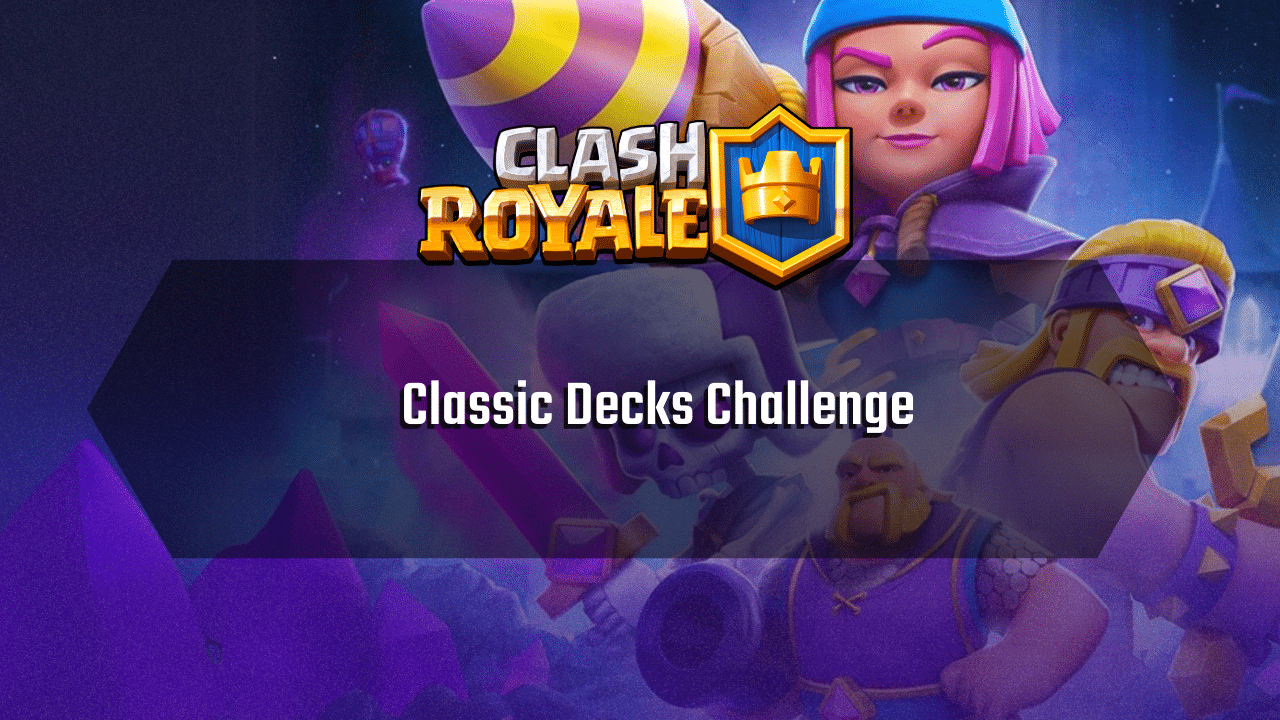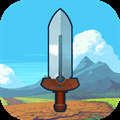Clash Royale Classic Decks Challenge - Theria Games

Introduction to the Classic Decks Challenge
The Clash Royale Classic Decks Challenge is an exciting event where players compete using pre-determined decks provided by the game. These decks often reflect popular strategies from the game’s past, giving players the chance to experience a variety of playstyles. In each match, players are randomly assigned one of these set decks, ensuring a dynamic and unpredictable experience.
The goal of the challenge is to achieve a specific number of wins, such as 8, 10, or 12, before reaching a set limit of losses, typically 3. Once the loss limit is reached, the challenge ends. This format creates a balanced environment where skill and strategy are key to progressing.
You can easily access the Classic Decks Challenge through the “Events” tab in the main screen of Clash Royale. Taking part in this challenge is a great way to master different deck types and refine your strategic approach to the game.
Understanding the Decks in the Challenge
The Classic Decks Challenge in Clash Royale offers players a diverse selection of pre-made decks, each representing a unique strategic approach designed to test various aspects of gameplay. These decks span a wide range of archetypes, from powerful beatdown decks like Golem Beatdown and Giant Graveyard, which focus on building large pushes and overwhelming opponents with heavy-hitting units, to cycle decks such as Miner Cycle and X-Bow Cycle, which emphasize speed, elixir management, and the ability to consistently apply pressure.
Players will also encounter spell bait decks like Log Bait and Zap Bait, designed to trick the opponent into wasting their spells, particularly the Log or Zap, allowing the deck’s win conditions to succeed more easily. These decks push players to think strategically, requiring careful timing with spells and counters to avoid wasting resources and falling into traps.
In this challenge, you’ll also encounter several iconic deck combinations that have been widely used in the past. For example, the P.E.K.K.A Ram deck uses a combination of P.E.K.K.A, Battle Ram, Magic Archer, and Bandit to create a fast and aggressive bridge spam strategy, applying constant pressure on the opponent. Another well-known option is Mortar Graveyard, which pairs the Mortar for defensive control with the Graveyard win condition, forcing the opponent into tough situations that require precise timing to defend.
Goblin Giant Sparky is another powerful combination, relying on the Sparky for devastating shots, paired with the Goblin Giant for tanking and support, enabling massive damage potential. Golem Beatdown, on the other hand, focuses on building a powerful late-game push with cards like Golem, Night Witch, and Elixir Collector, requiring careful elixir management to build up the push while defending against enemy counters.
For players who prefer air-based strategies, LavaLoon is a strong choice. It utilizes the Lava Hound and Balloon combination to apply relentless aerial pressure, supported by cards like Mega Minion and Electro Dragon to deal additional damage and control the battlefield. Giant Graveyard pairs the Giant as a tank with Graveyard, using a counter-push strategy that forces the opponent to focus on defending the swarm of skeletons while the Giant deals significant damage.
The Royal Hogs Cycle, often referred to as “Pigs on Parade,” relies on the synergy between Royal Hogs and Archer Queen to quickly cycle through cards and apply constant pressure, while X-Bow Cycle excels at fast cycling and punishing mistakes with the X-Bow, supported by cards like Tesla and Knight for defense. Meanwhile, Royal Giant Cycle decks often place the Royal Giant at the bridge with minimal support, cycling through cards like Fisherman and Hunter to maximize the Royal Giant’s tanking potential.
Log Bait decks focus on baiting the opponent’s Log with cards like Goblin Barrel, Princess, and Goblin Gang, clearing the way for further damage, while Zap Bait decks aim to force the opponent to use their Zap on small swarm units, leaving them vulnerable to other threats. The challenge also features unconventional decks like Giant Void with Wizard Evolution and Electro Giant Drill, incorporating newer mechanics and card evolutions. While these decks may not always be considered “classic” in terms of older metas, they offer a fresh approach that brings exciting new challenges to the table.
The inclusion of modern cards and evolutions introduces a layer of complexity to the challenge, pushing players to adapt and refine their skills with the latest mechanics. These newer additions present an opportunity to explore fresh strategies while still retaining the core principles of deck building and gameplay. As you progress through the Classic Decks Challenge, you’ll need to be flexible, adapting to each deck’s unique playstyle, honing your elixir management, mastering key card combos, and learning how to efficiently counter your opponent’s strategies.
Overall, the Classic Decks Challenge is a valuable opportunity to test your versatility and strategic thinking. By mastering a range of decks, learning how to effectively manage your elixir, and adapting to different matchups, you can refine your skills and deepen your understanding of the game’s mechanics. Whether you’re aiming for a high win count or simply looking to enhance your overall gameplay, the Classic Decks Challenge is an exciting and rewarding way to experience the depth of Clash Royale’s strategic gameplay.
Strategies for Success in the Challenge
Success in the Classic Decks Challenge in Clash Royale requires flexibility, quick adaptation, and a solid understanding of the various pre-determined decks assigned to you. Since you cannot customize your deck, your success depends on how well you can use the deck you’ve been given, regardless of your usual playstyle. One of the first steps is to quickly identify the deck archetype you’ve been assigned.
Understanding whether it’s a beatdown, cycle, bait, or control deck will shape your approach to the match. For example, with a Golem Beatdown deck, you’ll want to focus on elixir management early on to set up a large, powerful push later in the game. In contrast, a Miner Cycle deck will require you to focus on consistent chip damage, positioning your miner effectively while cycling through cards quickly to apply pressure.
Another key to success is recognizing your opponent’s deck as early as possible. The early game is crucial for understanding how your opponent plans to approach the match. By observing their card choices and playstyle, you can identify their deck archetype and begin to adjust your strategy accordingly. For example, seeing an Inferno Tower or Tornado early might indicate that your opponent is running a Log Bait deck, which requires you to be cautious about using your Log too early.
The challenge also emphasizes versatility. To succeed, you’ll need to master different playstyles, even if the decks don’t align with your usual preferences. Each deck in the challenge brings its own unique strategic requirements, and being able to play all of them effectively is key to winning. Recognizing the key cards and combos in your assigned deck is another important strategy. Understanding which cards work well together, like the synergy between Lava Hound and Balloon in a LavaLoon deck, will help you execute your deck’s win condition efficiently.
Adapting your gameplay to the flow of the battle is essential. What works against one opponent may not be effective against another, so being able to adjust based on what you see in the match is crucial. For example, if you’re facing a strong P.E.K.K.A with your Electro Giant, you may need to rethink how you approach the attack, as direct confrontation could be costly. Likewise, countering enemy troops is vital, especially when playing with unfamiliar decks. Knowing how to handle common threats like Electro Wizard, Inferno Tower, or Hog Rider is essential for maintaining control of the match.
Elixir management is always important in Clash Royale, but it’s even more critical when you’re unfamiliar with the deck you’re using. It’s easy to over-commit, especially with powerful cards, but managing your elixir efficiently can make the difference between winning and losing. Be mindful of both your elixir cost and your opponent’s, ensuring you don’t drain your resources too quickly, leaving you vulnerable to a counter-push.
As you continue playing, you’ll start to understand the matchup strengths and weaknesses of each deck. Some decks have natural advantages over others, so recognizing these strengths will allow you to adjust your strategy. For tough matchups, focus on defense, waiting for opportunities to capitalize on mistakes. In favorable matchups, feel free to apply pressure and control the pace of the game. Additionally, if your deck includes evolutions or Champions, knowing how to use these powerful cards at the right moment is critical. For instance, the Archer Queen can be a game-changer in the right situation, while the Battle Ram Evolution can deliver a significant offensive punch.
In certain cases, especially with slower beatdown decks, it can be helpful to be patient and let your opponent make the first move or overcommit. Observing their card cycle can give you valuable information, allowing you to set up an efficient counter-push. And finally, remember that the death penalty in the challenge is three losses. If you do lose a match, take the time to reflect on what went wrong. Was it a misplay, a poor card placement, or a misunderstanding of the opponent’s strategy? By learning from each loss, you can improve your approach and increase your chances of winning in the next round.
By focusing on mastering each deck’s unique strengths and weaknesses, adapting your playstyle to each matchup, and carefully managing your resources, you’ll be able to increase your chances of success and climb through the Classic Decks Challenge.
Conclusion
In conclusion, the Clash Royale Classic Decks Challenge provides an exciting and dynamic experience that tests a player’s adaptability and skill in a way that few other challenges do. Unlike standard gameplay, where players can choose and build their own decks, this challenge requires you to work with a wide variety of pre-made decks that span across different archetypes. These decks range from beatdown strategies like Golem Beatdown and P.E.K.K.A Bridge Spam to faster-paced, high-pressure cycle decks such as Miner Cycle and X-Bow Cycle, to more deceptive and tricky bait decks like Log Bait and Zap Bait.
Whether you are dealing with a heavy-hitting Golem deck that requires you to patiently build up elixir before making your big push, or a Miner Cycle deck where the goal is to apply constant chip damage while cycling quickly, each deck requires a different approach, making it essential for players to master a variety of strategies. The diversity of decks ensures that no two matches will be exactly the same, providing a constant flow of challenges that keep the experience fresh and engaging.
One of the most important aspects of this challenge is understanding the deck you’ve been assigned right from the beginning. Each deck has a distinct playstyle, and recognizing this early can help you quickly plan your strategy for the match. For example, if you receive a Golem Beatdown deck, you’ll want to focus on elixir management early in the game to ensure you have enough resources for a massive push once Double Elixir is available. On the other hand, with a Miner Cycle deck, your focus will likely shift to consistently applying pressure on your opponent’s towers, making use of your low-cost cycle cards to gain chip damage without leaving yourself vulnerable.
The key is to identify the deck’s win condition and find the most efficient way to protect it while also countering your opponent’s threats. Recognizing the archetype of your opponent’s deck early on can give you an edge, as it allows you to anticipate their moves and adjust your tactics accordingly. For instance, if your opponent drops an Inferno Tower early in the match, this is a clear sign they are likely playing a Log Bait deck, and you should adjust your strategy to avoid using your Log or Zap prematurely, saving them for key moments when you can clear their Goblin Barrel or Goblin Gang.
On the other hand, a Hog Rider paired with a Fireball may signal a Hog Cycle or Control deck, and you’ll need to prepare to defend with cards like Tornado or P.E.K.K.A to counter their pushes.
Effective elixir management is essential to succeeding in this challenge, especially when you’re playing with decks you’re not familiar with. Learning when to be aggressive and when to play defensively is critical. Overcommitting to one push could leave you vulnerable to a counter-push, especially when you don’t have the right cards in hand to defend effectively. Efficient elixir usage also means knowing when to cycle cards, ensuring that you have the right responses ready for whatever your opponent may throw at you.
A well-timed Tornado to pull an enemy Hog Rider into your King Tower can make all the difference, or a Log used to clear a Goblin Barrel at the right moment can prevent massive damage to your tower. Similarly, learning to use key card combos effectively is another integral skill. For example, Lava Hound paired with Balloon creates a devastating push that can overwhelm your opponent if not dealt with properly, while P.E.K.K.A and Bandit can work well together to eliminate high-health troops while applying pressure to the tower. Understanding how each card in your deck interacts with the others will allow you to execute these combos with precision.
In addition to all this, the Classic Decks Challenge also demands that players become highly versatile. You may be accustomed to playing a specific style of deck—whether it’s cycle, control, or beatdown—but in this challenge, you will need to step out of your comfort zone and adapt to whatever deck you’re given. Versatility is key, as you could end up facing a variety of deck types with completely different strategies. For example, if you’re used to playing fast cycle decks, you might struggle against a Golem Beatdown or Giant Graveyard deck, where patience and careful elixir management are essential.
Conversely, if you’re comfortable with heavier decks, you may find yourself in a Miner Cycle match, where you need to focus on chipping away at the opponent’s tower without committing too much at once. Whether you are playing with Electro Giant Drill, a Royal Giant Cycle, or LavaLoon, learning to adjust your tactics and counter your opponent’s moves effectively is a crucial part of mastering this challenge.
As you continue to play and progress through the Classic Decks Challenge, you will start to better understand the matchups and how certain decks perform against others. For instance, a Royal Hogs deck with Earthquake can be particularly difficult to handle if you don’t have the right counter in hand, while X-Bow decks may require a different approach depending on your opponent’s card cycle.
Some matchups will be more favorable, and others will force you to play more defensively, looking for small openings and waiting for the right moment to strike. Learning how to counter enemy cards effectively, such as using P.E.K.K.A to deal with Electro Giant or Bowler to stop Hog Rider pushes, will be critical in managing your elixir efficiently and maintaining a defensive advantage.
Ultimately, the Classic Decks Challenge is an opportunity for players to test their strategic thinking and adaptability. By mastering various deck types, learning effective elixir management, practicing countering enemy strategies, and understanding the synergies within each deck, you can increase your chances of success and reap the rewards this challenge has to offer.
The challenge not only enhances your gameplay but also offers a chance to refine your decision-making under pressure, as each match will present unique situations that require quick thinking and adaptation. Whether you’re aiming for the maximum number of wins or simply looking to improve your overall Clash Royale skills, the Classic Decks Challenge is a valuable opportunity to grow as a player, further developing your understanding of the game’s deeper mechanics and building a more versatile skill set.













